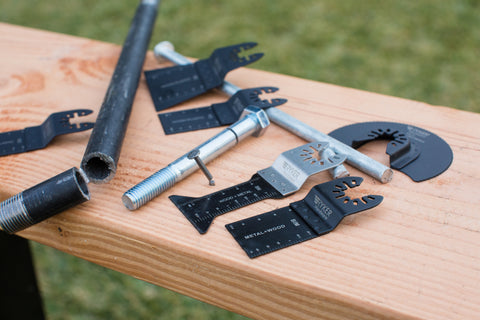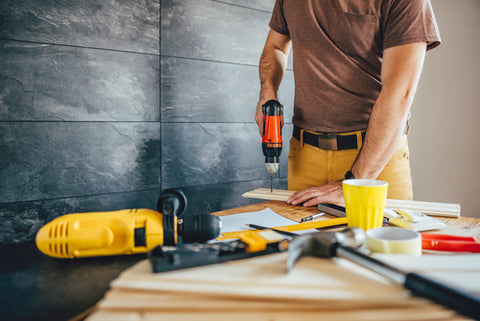Are your tools living their strongest, longest lives?
Tool replacement, especially at a frequent rate, is one of the greatest expenses for any contractor or professional. Whether you’re replacing your hammers monthly or your floor grinders yearly, the cost of tools can quickly add up and kill your net profits.
Extending the life of your tools means minimizing your costs. The best way to extend the life of your tools is with proper tool maintenance.
Tool maintenance also makes the job safer, more efficient, and more effective—which will make you, your employees, and your clients happy.
So what should you be doing to care for your tools to save money, time, and resources for your business?
1. Clean tools after use.
Cleaning tools after use and before putting in storage is a necessary habit for all professionals. A few minutes of tool TLC can protect from damage and save time when you go to use that tool again.
Start by wiping down the tools with a rag or old towel. This helps get rid of dust, grease, and debris, especially in tools with moving parts. Some professionals will keep a bucket of rags near storage so it’s easy and fast to wipe down tools before putting away.
You should also do a deeper clean periodically, after every few uses. Use a damp cloth to clean all parts of the tool, paying extra attention to moving parts and crevices. Dip a cotton swab in all-purpose oil to reach hard-to-clean areas. You can also use an air compressor or can of compressed air to blow air into vents and crevices. Make sure to dry the tool with a clean rag after washing.
Pro-tip: Always unplug tools after use. Do not clean, repair, or store tools that are still connected to a power source.
2. Check for wear and tear.
After cleaning, it’s a great opportunity to take a few seconds to look over your tools. You want to see if there are any defects or damaged areas.
Look for:
- Corrosion and rust
- Splinters and breaks
- Cracked housing
- Loose, cracked, or splintered wooden handles
- Mushroomed heads on chisels and wedges
- Frayed insulation or exposed wires
You may also want to turn on your power tools to make sure they start easily. If they don’t, add lubricant and try again. If they still don’t power up with ease, they may need to be repaired.
Pro-tip: Pay extra attention to power cords. We tend to look at the tool itself without considering its attachments or cords. But frayed insulation or exposed wires can cause electric shock or fire, which can create a high risk for your employees and business. Don’t mess with wires.

3. Make repairs.
If there are any signs of damage, don’t use the tool. Using a broken tool can cause serious injury.
If you spot any of the above wear and tear, don’t store your tools with the idea that you’ll “fix it later.” Fix it now while it’s top of mind. You don’t want to put it away and forget that it’s broken for the next time you try to use it. Doing so can cause serious injury to the worker and complete damage to the tool.
Here are a few ways to quickly and effectively repair the most common damage concerns.
Remove rust. Use a rust remover or WD-40, and scrub with steel wool or a stiff wire brush. Rinse with warm, soapy water. Scrub again with a damp cloth or rag to remove leftover signs of rust. Dry with a clean rag. If this doesn’t work, you may need to soak the tool in rust remover overnight.
Tip: Make sure you wear heavy gloves because you don’t want to expose skin to rust. You should also wear safety goggles, especially when working with rust and steel wool.
Sand down wooden handles. Handles should be smooth enough to slide your hand on. If your wooden handles are rough and weathered, they should be sanded down. Start by sanding across the grain quickly, brushing back and forth. Use a rougher grit. Then, finish with a lighter grit by sanding with the grain. Wipe the handle with a coat of linseed oil to revive and protect the wood.
Sharpen tools. All bladed tools need to be sharpened once per season or when they start to get dull. This includes saw blades, shovels, pruners, and lawn and garden tools. If blades start to wear down, the power tool has to work harder to get the job done; this can stress out the motor and cause further damage to the parts. It also doesn’t do the job as well.
Use a coarse file working edge to a 45-degree bevel. You may want to invest in professional sharpening tools. Don’t forget to keep your sharpeners sharp as well.
For other sorts of repairs, like frayed wires, you may need to work with a repairman or the manufacturer to get it repaired or replaced.
Pro-tip: You should have a worktable near your tool storage. This is a place where you can inspect your tools and perform repairs safely and quickly. Cover it with newspaper or plastic sheeting to make it easier to clean up
4. Add lubricant.
After cleaning and repairing, you want to lubricate your tools. This helps prevent corrosion and rust, so they’re fresh and ready the next time you want to use them. You especially want to lubricate tools with adjustable or movable parts to ensure they don’t rust or harden into place.
You’ll likely want to use an all-purpose oil like WD-40. You can spray it directly on the adjustable parts of the tool for more powerful lubrication, or you can spray on a rag and rub on to help reach inside crevices and cracks.
You can lightly spray the oil other metal parts of the tool for extra protection.
Make sure that you wipe away any excess oil with a rag before storing.

5. Store tools properly.
After tools are clean, repaired, and lubricated, they’re ready to be stored.
You want to store tools in a cool, dry place. Keep them away from excessive heat or cold, which can damage tools, especially electronics like power drills. You also want to protect your tools from water or moisture, which cause rusting and corrosion.
The best way to protect from dust, dirt, and moisture is with a toolbox, chest, container, or shelving unit. You’ll want to keep the majority of your tools in an enclosed area rather than open and exposed. You might want to consider storing tools in their original boxes.
Each tool should have a designated spot where it’s stored easily and safely. This protects tools from the elements and ensures the safety of those using the tools. It can also help you quickly determine which tools are missing, in use, or being repaired.
Pro-tip: Put silica gel packs in the toolbox. This helps remove excess moisture to avoid rust and corrosion.
6. Take care of power tool batteries.
Batteries can be incredibly dangerous if they break or heat up. They can also be expensive to replace. If batteries corrode inside your tool, they can also cause damage to the tool itself.
After using your tools, remove the batteries and store separately. This can help ensure that batteries don’t break and damage your tools. Plus, some batteries can actually wear out faster if you keep them inside the tool, so removing them can help extend their life.
Store batteries in a cool, dry place. Moisture and extreme temperatures, especially heat, can cause serious battery corrosion. Even storing next to the tool they go with can work well.
Most power tools use lithium-ion batteries, which are known to overheat and fry. Keep these in controlled areas without temperature spikes, and don’t let the battery run down completely before recharging.
7. Watch for overheating.
Power tools can quickly start to heat up, especially if they’re being overworked or kept running for too long. Make sure that you let your tool cool down if it’s getting hot, even in the middle of a project. This saves you from wearing out the motor or burning parts of your tool, which can cause fires, shocks, or expensive repairs.
8. Recalibrate frequently.
Power tools are precision instruments. Using them for a while can cause them to lose alignment. This can cause damage to the tools or the project on which you’re working.
Check the instruction manual to see how frequently you should recalibrate your tool. You’ll likely need to recalibrate every few hours to avoid damage.
9. Follow manufacturer instructions.
Always follow the instruction manuals for your tools with regards to lubrication, repair, sharpening, and storage. You’ll also want to follow these instructions for replacing exhausts, batteries, and filters.
You should keep all tool manuals with you. Store them in a folder or filing cabinet for easy access.
Read these manuals and encourage your employees to do the same to ensure the safest and most effective use of your tools.
Conclusion
Taking care of your tools is the best way to extend their life, save your wallet, improve efficiency, and protect your workers’ safety. Proper tool maintenance doesn’t have to be hard if you make these steps a habitual part of your daily routine.
Not sure how to implement these tool care tips into your workday? Not sure how to get your team on board?
Contact Ryker Hardware to work with a team of customer service professionals ready to provide insights for your professional business.
We look forward to hearing from you!

Leave a comment